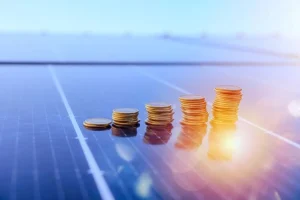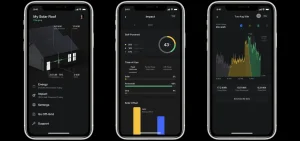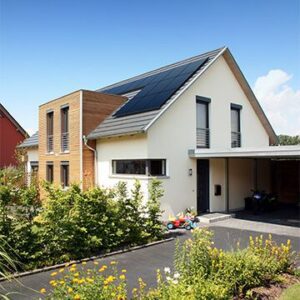
As the world increasingly embraces renewable energy sources, solar panels have become a symbol of sustainable power generation. Homeowners and businesses alike are eager to reduce their carbon footprint and energy costs by harnessing the sun’s energy. In this quest for cleaner and more cost-effective energy, Tesla, a name synonymous with innovation, has stepped into the arena. In this comprehensive review, we’ll delve into the world of Tesla solar panels, exploring their features, benefits, costs, and potential drawbacks.

Personal Experience with Tesla Solar Panels
Tesla solar panels in Singapore demonstrate excellent performance, efficiently harnessing solar energy even in varied tropical weather. They seamlessly integrate with the grid, allowing homeowners to earn credits for excess energy, with a notable credit rate of S$0.21 per kWh under Singapore’s net metering policy. The incorporation of Tesla Powerwall batteries ensures consistent power supply, enhancing energy independence.
The financial aspect involves an initial investment of $120,948.04, covering the complete solar system and batteries. However, this is offset by substantial long-term savings, with an estimated payback period of 9.6 years, supported by a 25-year warranty on the panels.
Overall, Tesla solar panels present a highly efficient and financially sensible solution for sustainable energy, leading to significant reductions or complete elimination of electricity bills.
Understanding Solar Systems and Grid Integration
For those unfamiliar with solar systems, they essentially comprise a network of photovoltaic panels that convert sunlight into electricity. These panels are typically installed on rooftops and generate electricity during the day, which can be used to power homes, businesses, or even charge electric vehicles.
In Singapore, homes are connected to the national electricity grid, which serves as a central source of power. When a household’s energy demand exceeds the amount generated by its solar panels, it draws additional electricity from the grid. Conversely, when a household’s solar panels generate excess electricity, it can be fed back into the grid, earning credits that can offset future electricity consumption.
The Role of Batteries in Solar Systems
Batteries play an integral role in solar systems, particularly for those seeking energy independence. They store excess solar energy generated during the day, allowing homes to utilize this stored energy even at night or during power outages.
Achieving Zero-Dollar Electricity Bills with Net Metering
Net metering is a crucial policy that encourages solar adoption by allowing homeowners to sell excess solar energy back to the grid. This effectively reduces or eliminates their electricity bills.
In Singapore, net metering is offered through the Energy Market Authority (EMA). Under the current scheme, homeowners can receive a credit of S$0.21 per kWh for excess electricity exported to the grid.
Tesla Solar Panel Performance in Singapore
Based on my year-long evaluation, Tesla solar panels have demonstrated remarkable performance in Singapore’s tropical climate. They consistently generate a significant amount of electricity, even during periods of cloudy or rainy weather.
Factors Affecting Solar Panel Performance
While solar panels are a dependable source of clean energy, their performance can be influenced by various factors:
-
Roof Orientation: South-facing roofs receive the most sunlight, maximizing energy generation.
-
Shading: Trees or buildings casting shadows can reduce panel efficiency.
-
Weather Conditions: Sunnier climates and predictable weather patterns enhance solar performance.

Achieving Energy Independence with Tesla Solar Panels
By combining Tesla solar panels with Powerwall batteries, homeowners can attain a high degree of energy independence. This empowers them to power their homes primarily with solar energy, reducing their reliance on the grid and contributing to a more sustainable future.
For those seeking to take their sustainability journey to the next level and achieve complete energy independence from the grid, Tesla Powerwalls offer a compelling solution. By combining Tesla solar panels with Powerwall batteries, homeowners can store excess solar energy generated during the day and utilize it at night or during power outages, effectively eliminating their reliance on the grid.
The Benefits of Tesla Powerwalls
-
Complete Energy Independence: With Tesla Powerwalls, homeowners can theoretically achieve complete energy independence, never drawing power from the grid and operating entirely on stored solar energy.
-
Uninterrupted Power Supply: Powerwalls ensure uninterrupted power supply even during grid outages, providing peace of mind and eliminating the reliance on backup generators.
-
Sustainable Energy Storage: Powerwalls store excess solar energy, reducing dependence on fossil fuels and promoting sustainability.

Tesla App for Seamless Monitoring and Control
The Tesla app provides a user-friendly interface for homeowners to monitor and control their solar energy system. Through the app, users can track energy production, consumption, and storage, optimize energy usage, and receive real-time insights into their system’s performance.
The Installation Process and Tesla App
The installation process for Tesla solar panels and Powerwalls can be lengthy, typically taking several months from initial planning to final activation. However, Tesla assigns a dedicated advisor to guide homeowners through the process, handling paperwork, inspections, measurements, and material ordering.
The Tesla app serves as a central hub for monitoring and managing the solar energy system. It provides real-time insights into energy production, consumption, storage, and grid usage, allowing homeowners to optimize their energy usage and track their progress towards energy independence.

Understanding Energy Production and Consumption
Kilowatts (kW) measure power, while kilowatt-hours (kWh) measure energy. One kW is equal to 1,000 watts. kWh is the unit used to measure the amount of energy collected by the solar panels. A Tesla Model S battery, for instance, has a capacity of approximately 100 kWh.
A Powerwall 3 has a capacity of 13.5 kWh, and three Powerwall 3s together have a total capacity of 40.5 kWh. These batteries can support a maximum power output of 15.5 kW.
The theoretical maximum power output of the solar system is 29.3 kW. However, this number may vary depending on factors like weather conditions and shading.
Learning from Energy Usage Patterns
Observing energy usage patterns through the Tesla app can reveal insights into household energy consumption. Basic household operations, even with lights turned off, can consume around 400 watts.
Charging phones, turning on lights, or using computers have minimal impact on energy consumption. Microwave ovens and toasters can cause sudden spikes in energy usage.
Air conditioning and electric car charging are the two most significant energy consumers in most households. Electric car charging consumes the most energy overall.
By understanding these usage patterns, homeowners can make informed decisions about energy usage and optimize their solar energy system’s efficiency.
Energy Production and Consumption Throughout the Year
The performance of Tesla solar panels varies throughout the year due to seasonal changes in sunlight intensity and household energy consumption patterns.
Summer:
-
Longer daylight hours and higher sunlight intensity lead to increased solar energy production.
-
Air conditioning usage surges during summer, increasing household electricity consumption.
-
Net grid usage is typically zero or slightly negative, indicating excess electricity generation.
Monsoon or Rainy and Cloudy Season:
-
Shorter daylight hours and lower sunlight intensity result in reduced solar energy production.
-
Air conditioning usage decreases, reducing household electricity consumption.
-
Net grid usage remains low or slightly negative, indicating continued excess electricity generation.
Financial Considerations and Payback Period
The initial cost of a Tesla solar panel system with Powerwalls can be significant. However, the long-term savings from reduced or eliminated electricity bills can offset the upfront investment.
-
In this example, the total system including solar tiles, materials, labor, installation, and the three batteries, cost was $120,948.04.
-
The estimated payback period is 9.6 years, based on an average monthly electricity cost of $9,660.
-
The payback period can be influenced by various factors, including system size, electricity consumption patterns, and electricity rates.
Naturally, my expenditure on gas has been nonexistent during this period. When the overall cost of my installation is considered, the payback period for my solar setup is approximately 9.6 years, just under a decade. This aligns with the typical payback period for solar installations, which, according to standard online sources, ranges from six to ten years.
This is particularly advantageous considering that the solar panels come with a 25-year warranty. Effectively, after the 10-year mark, the panels will continue to provide financial benefits for an additional 15 years or as long as I reside in the house.
Although my payback period is on the higher end of the average spectrum, I’m not particularly concerned. There were alternatives that could have potentially shortened this period. The most obvious solution would be opting for a less costly setup. However, it’s crucial to consider the overall efficiency and coverage of the system.
For instance, I could have chosen a less expensive Tesla solar panel array, which due to the unique design of my roof, would have offered a smaller 19 kilowatt array instead of the 29 kilowatts provided by the solar tiles. This choice, though possibly reducing the payback period, would also have resulted in less electricity generation.
Strategies to Improve Payback Period
-
Optimize system size: Choose a system size that matches your household’s energy needs to maximize solar energy utilization.
-
Reduce electricity consumption: Implement energy-efficient practices to lower overall electricity usage.
-
Consider additional electric appliances: Replacing gas-powered appliances with electric alternatives can increase electricity consumption and reduce the payback period.
Originally, I sought an estimate for a less extensive solar panel setup, pondering if it would lead to a quicker payback. However, the potential reduction in electricity generation left me uncertain about whether it would actually expedite the return on investment. Presently, I’m considering increasing my electricity consumption to maximize the system’s benefits.
Since I consistently produce more energy than I use, I’m thinking about converting more of my appliances to electric, possibly including my heating system, to enhance the system’s efficiency in the future.
Regarding the interesting aspects of this advanced technology installed on my roof, one notable feature is achieving a zero-dollar electricity bill for an entire year. Interestingly, this was maintained even during the three winter months when I consumed more grid energy than I produced. This was possible due to the mechanism of net metering credits, which accumulate monthly and reset annually.
In the first complete month of operation, in August, my solar production exceeded consumption, resulting in a credit of negative 255 kilowatt hours reflected on my bill. This credit allowed me to maintain a zero-dollar bill in subsequent months, even when my usage exceeded solar production. Throughout summer and autumn, I accumulated more credits, which offset my higher energy use in winter, keeping my monthly bills at zero dollars.
The Tesla app frequently notifies me about my disconnection from the grid, reassuring me that the house is running efficiently on solar and battery power. It also provides updates on the backup power duration, ensuring continuity until the sun rises again. An additional feature, the storm watch, automatically ensures the Powerwalls are fully charged in anticipation of severe weather.
Conclusion
The peace of mind offered by this system is significant. Knowing that the Powerwalls can sustain normal household functions, including air conditioning and other appliances, until the next day without charging the car, is reassuring. This capability suggests the potential for my home to operate completely off-grid for extended periods, provided I have an alternative charging option for my electric car.
Tesla solar panels, coupled with Powerwalls and net metering policies, offer a compelling solution for homeowners seeking to reduce their grid reliance, achieve energy independence, and embrace sustainable energy practices. The ability to maintain zero-dollar electricity bills, enjoy reliable backup power, and potentially achieve off-grid independence makes this a viable option for those committed to a sustainable future.
Explore our diverse selection of solar solutions and embark on a journey towards energy efficiency and environmental stewardship. Your sustainable future starts here. Contact us today!
Additional Resources:
Solar Panel Cost
Solar Panel for Condos
Solar Panel Expert Guide